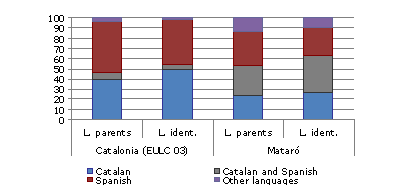
From
monolingual family background to bilingual identification: the case
of pre-adolescents in Mataró and the Aragonese border area(1)
by Vanessa
Bretxa, Llorenç Comajoan and Natxo Sorolla |
||||
| CONTINUA |
Table 3. Coding of the variable "Language used with parents"
The index to assess attitudes to Catalan was based on answers to 10 items, 5 of which indicated a positive attitude to the language while 5 showed negative attitudes. The scale of attitudes goes from -1 to 1. On this scale -1 signifies an unfavourable attitude to Catalan, while 1 indicates a favourable attitude. The index for confidence combined 12 items, 6 of which were related to language confidence and 6 to anxiety. The index for confidence ranges from -1 to 1. On this scale -1 indicates a lack of confidence in Catalan and 1 indicates confidence when speaking Catalan. Language competence takes only one item into account: the respondent's self-assessment of his/her ability to speak Catalan on a scale from 0 to 10, where 0 indicates that the respondent cannot speak Catalan at all and 10 indicates complete fluency in Catalan. Finally, to assess the social network the index was based on the number of friends and classmates given by each respondent and the language in which they spoke to each other. The index is a scale from 0 to 1 on which 0 siginifies that the person never uses Catalan with friends and classmates and 1 indicates that Catalan is the only language used with them. To analyse the data descriptive techniques (percentages) and multivariable discriminant analysis were used. Discriminant analysis enables us to verify and confirm the consistency of the distinction between different groups of subjects. The fundamental objective of this technique is to analyse and explain the differences between groups in such a way that it is possible to predict the likelihood of a person's belonging to a particular group. 4.1.
Language used with parents and language of identity Table 4. Language used with parents and language of identity in Catalonia and Mataró i Mataró
Note: Data for Catalonia are from the EULC 03 study. Data for Mataró is drawn from this study. Graphic 1. Language used with
parents and language of identity in Catalonia If we compare data for all of Catalonia and Mataró on the language used with parents, it will be seen that most of the population of Catalonia uses either Spanish (50.3%) or Catalan (39.5%). In Mataró, on the other hand, in the case of pupils aged 11-12, it will be observed that a considerable percentage speak to them in both Catalan and Spanish (29.4%, as against 6.9% for the whole of Catalonia). A similar trend can be observed if we compare the language of identity in Catalonia and in Mataró. While only 5.2% of respondents among the population of Catalonia identify with both Catalan and Spanish, 36.3% of the Mataró pupils identify with both languages. If we compare data for language used with parents and language of identity in Table 4, three trends can be observed.(5) First, the percentage of respondents who report Spanish as the language they use with their parents is higher than the percentage who identify with Spanish (33.8% and 27.2% respectively). Secondly, the percentage of pupils who identify with both Catalan and Spanish is higher than the proportion who report that they use both languages with their parents (36.3% and 29.4% respectively). Lastly, the difference between those who identify with Catalan and speak Catalan with their parents is not so marked as in the other cases mentioned (26.6% and 23.8%, respectively). Table 5 (Figure 2) allows us to compare the total population of the Aragonese border area with data for pre-adolescents in this area. Of the whole population, the majority use Catalan when speaking to their parents (71.6%), followed by Spanish (19.6%), while only a small percentage (8.1%) use both Catalan and Spanish. However, if we consider the pre-adolescent population, the percentage who use both Catalan and Spanish with their parents is 29.3%. Regarding the language of identity, the figures show that 35.5% of the pre-adolescent population identify with both Catalan and Spanish, while only 3.1% of the whole population of the Aragonese border area identified with both languages. |
||||||||||||||||||||||||||||||||||||||||||||||||||||||||||||||||||||||||||||||||||||||||||||||||||||||||||||
